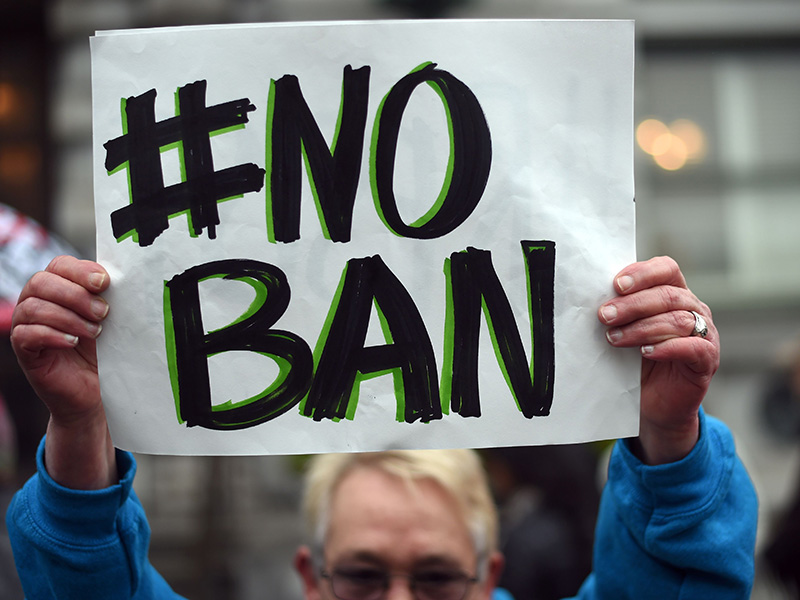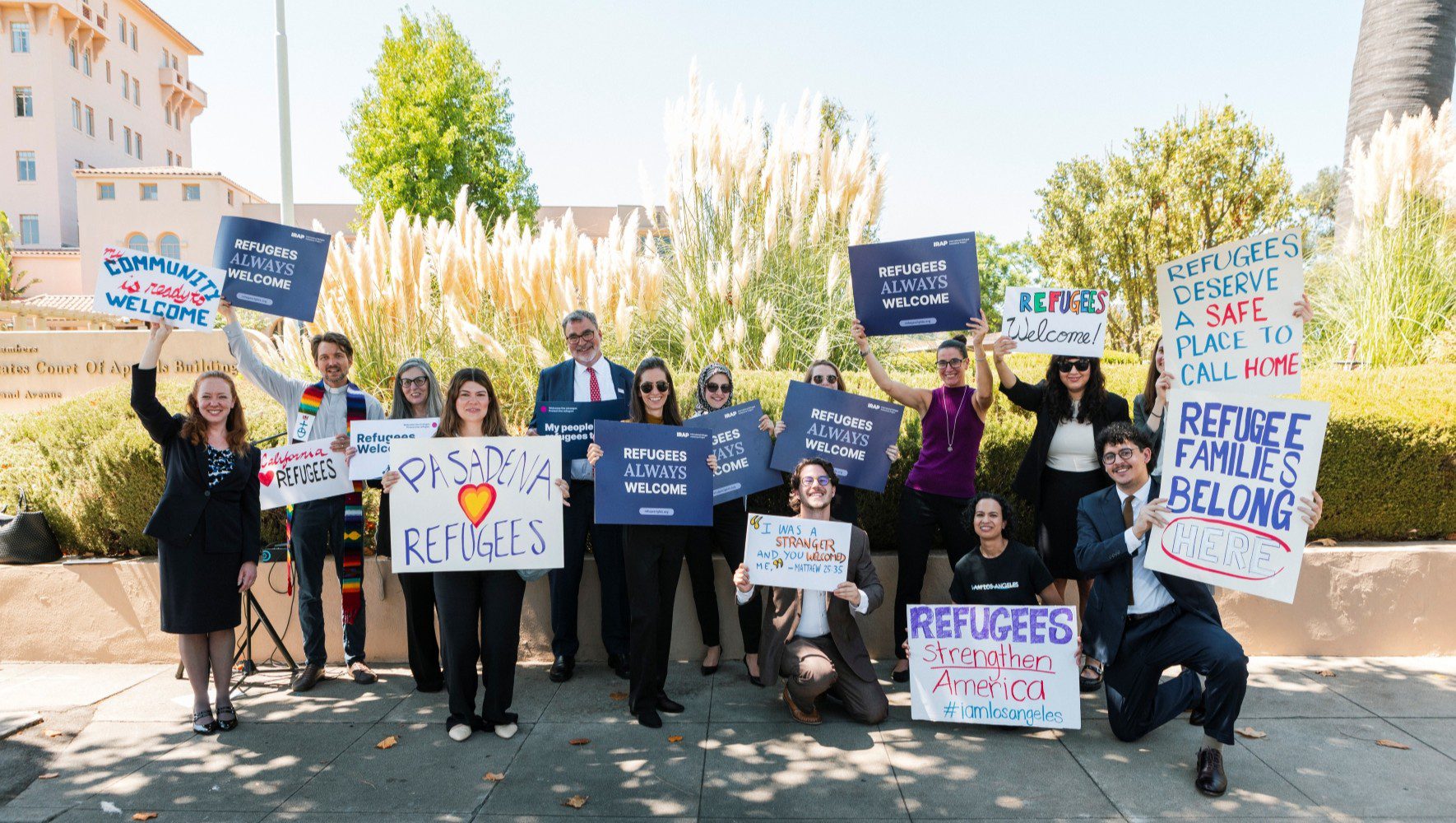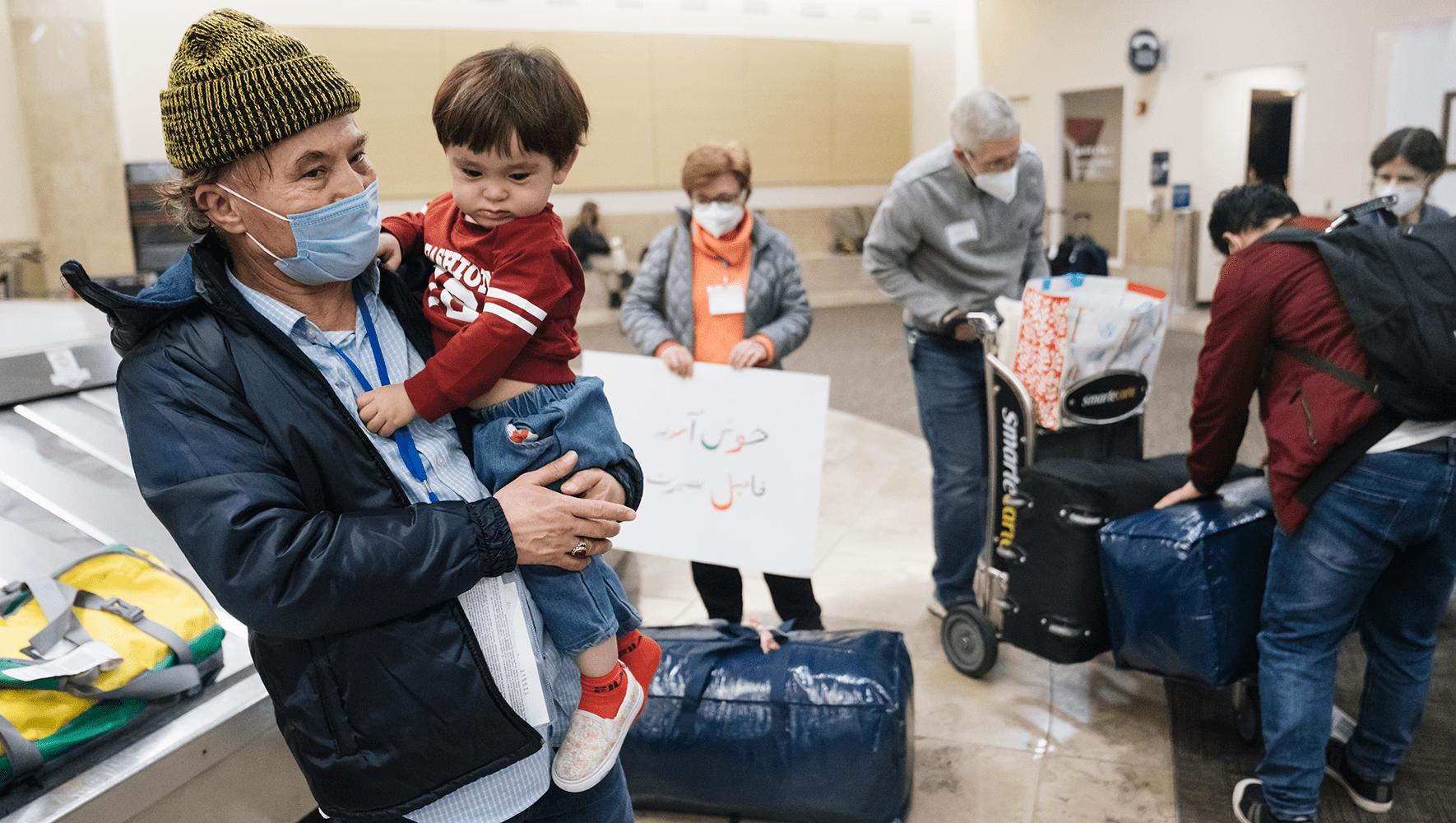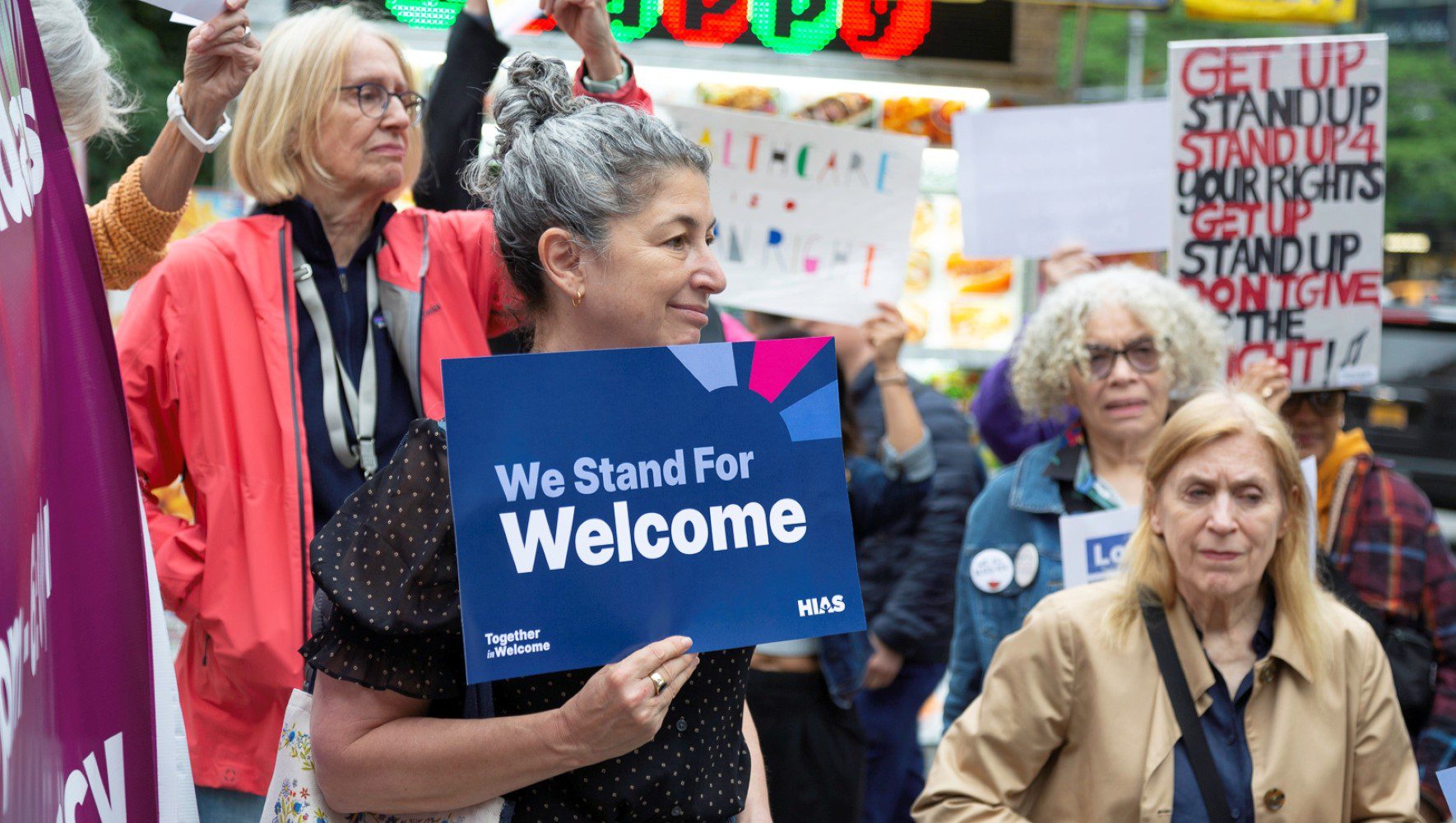Tracking The Refugee Ban
By Gabe Cahn, HIAS.org
Jul 18, 2017

Karen Shore holds up a sign in front of the United States Court of Appeals for the Ninth Circuit in San Francisco, California on February 7, 2017.
(Josh Edelson/AFP/Getty Images)
UPDATED DECEMBER 23, 2017
After dozens of lawsuits and countless protests, the fight to ensure that the United States remains a welcoming country is just as critical as the moment the first refugee and Muslim ban was signed.
Every day, HIAS and its partners in local communities across the country continue to mobilize in support of refugees and to urge the U.S. government to do more—not less—to respond to the largest displacement crisis in human history.
Still, the whirlwind of refugee-related executive orders, legal actions and court rulings up to this point can seem like a blur. So, how did we get here? Below is a timeline recapping the lifespan of the refugee ban from the day it was signed through the Trump administration’s most recent appeal to the Supreme Court.
Refugee Ban 1.0
- January 27—One week into office, on International Holocaust Remembrance Day, President Trump signs an executive order banning refugee admissions for 120 days, reducing the number of refugee admissions for this fiscal year to 50,000 (from the 110,000 level set by President Obama), and prohibiting the entry of foreign nationals from specific Muslim-majority countries for 90 days. Almost immediately, chaos ensues at U.S. airports and nationwide protests commence.
- February 3—A federal judge in Seattle issues a temporary restraining order against the executive order.
- February 7—HIAS and the International Refugee Assistance Project (IRAP), with legal representation from the ACLU and the National Immigration Law Center, file a lawsuit challenging the constitutionality of the executive order in the U.S. District Court for the District of Maryland, Southern Division.
- February 9—The Ninth Circuit Court of Appeals upholds the federal judge in Seattle’s restraining order against the executive order.
Refugee Ban 2.0
- March 6—President Trump signs a revised version of his initial executive order designed to have largely the same effect as the first, set to go into effect on March 16, 2017.
- March 10—HIAS and IRAP amend their litigation to challenge the revised executive order.
- March 15—Thanks to district court rulings in HIAS and IRAP’s case, as well as in a parallel case brought by the State of Hawaii, the second version of the ban is stalled just hours before it was set to go into effect.
- May 25—After the government appealed and oral arguments were heard in HIAS’ case, the United States Court of Appeals for the Fourth Circuit rules overwhelmingly in favor of HIAS, IRAP and the other plaintiffs, opting to keep the most of the injunction against the ban in place.
- June 12—Following a similar government appeal and oral arguments in the Hawaii case, a three-judge panel from the United States Court of Appeals for the Ninth Circuit rules unanimously to keep the refugee and Muslim ban on hold, the second defeat for the March 6 executive order at the circuit court level.
The Supreme Court Weighs In
- June 26—The United States Supreme Court responds to the government’s emergency motion to overrule the lower courts’ injunctions against the March 6 revised executive order, as well as their appeal to hear the case during the fall term.
The Court announces that it will hear arguments for the case in the fall, and also issues an order keeping in place much of the lower court rulings which prevent the administration from implementing the ban in full. As part of the order, however, the Supreme Court specifies that refugees and foreign nationals who have a “bona fide relationship with a person or entity in the United States” are exempt from the ban.
- June 29—The Trump administration issues guidance on how it plans to implement the Supreme Court’s parameters. The administration's restrictive guidance includes narrow definitions of “bona fide relationships,” excluding grandparents, grandchildren, aunts, uncles, nieces, nephews, cousins, brothers-in-law and sisters-in-law. Importantly, the administration also announces that ties to resettlement agencies are not expected to be considered as a “bona fide" relationship, leaving thousands of already vetted and cleared refugees in limbo.
Challenging the Administration’s Interpretation of Supreme Court Ruling
- July 12—Following attempts to persuade U.S. District and Circuit courts to clarify the Supreme Court language, the refugee ban goes into effect using the administration's narrow interpretation. Refugees who cannot prove the “bona fide” relationships as defined by the administration, even after they had been vetted by the U.S. government, have their travel plans cancelled.
- July 13—A day after the partial ban is in effect, U.S. District Judge Derrick Watson, in response to a second motion filed by the State of Hawaii and supported by HIAS and IRAP, halts the implementation of key portions of the executive order, citing HIAS’ arguments in several instances.
As a result of the ruling, refugees with “assurances” from U.S.-based resettlement agencies are officially considered to have “bona fide” relationships with a U.S. entity, as defined by the Supreme Court. Additionally, the judge’s decision expands the administration's overly narrow interpretation of which close family ties would qualify to be exempted from the refugee ban, which had originally excluded even grandparents and grandchildren.
- July 14—In response to the district court ruling, the Trump administration announces that it will appeal directly to the Supreme Court in an effort to implement its original interpretation of the refugee ban.
- July 19—The Supreme Court denies the administration's motion to clarify the Court's June 26 order, but stays the portion of the July 13 district court ruling related to refugees with "assurances" from U.S. resettlement agencies, pending resolution by the U.S. Court of Appeals for the Ninth Circuit Court.
- August 9—The U.S. Court of Appeals for the Ninth Circuit Court schedules oral arguments in State of Hawaii v. Trump for August 28.
- August 28—A three-judge panel from the U.S. Court of Appeals for the Ninth Circuit Court hears oral arguments in Seattle on whether grandparents, aunts, uncles and other close family members, as well as refugees with assurances from U.S.-based resettlement agencies, should be exempt from the Trump administration's Muslim and refugee ban.
- September 7—The U.S. Court of Appeals for the Ninth Circuit issues a ruling affirming that grandparents, aunts, uncles and other close family members, as well as refugees with assurances from U.S.-based resettlement agencies, are exempt from the Trump administration's Muslim and refugee ban.
- September 11—U.S. Supreme Court Justice Anthony Kennedy temporarily grants the Trump administration's appeal to limit the Ninth Circuit Court of Appeals' September 7 ruling that refugees with assurances from U.S.-based refugee resettlement agencies, such as HIAS, would be exempt from the ban according to the Supreme Court order’s definition of “bona fide relationships” with a U.S. entity.
-
September 12—The Supreme Court rules that refugees with assurances from U.S.-based refugee resettlement agencies, such as HIAS, are not exempt from the ban according to the Court's definition of a “bona fide relationship” with a U.S. entity.
Travel Ban 3.0
- September 24—The Trump administration, citing national security concerns, issues a new order indefinitely banning most travelers from Iran, Syria, Yemen, Libya, Somalia, Chad North Korea and Venezuela.
- September 25—In light of the new travel restrictions announced by the Trump administration, the Supreme Court cancels the oral arguments scheduled for October 10 and calls for briefs from both sides on whether the case is moot.
- October 10—While expressing no views on the merits of the case, the Supreme Court decides to dismiss Trump v. IRAP as moot due to the fact that the travel restrictions in question expired on September 24.
- October 16—U.S. District Court Judge Theodore D. Chuang hears oral arguments for International Refugee Assistance Project v. Trump—the case HIAS is a part of—together with two other cases challenging the new ban: Zakzok v. Trump and Iranian Alliances Across Borders v. Trump.
- October 17—Separately, in Hawaii, U.S. District Judge Derrick K. Watson blocks the Trump Administration's new travel ban just hours before it goes into effect. The ruling was in response to the case brought by the State of Hawaii and others.
- October 18—Overnight in Maryland, U.S. District Judge Theodore D. Chuang issues his own preliminary injunctions against the travel ban, citing several of President Trump's previous statements toward Muslims as grounds for possible violations of the Constituional protection against favoring or discriminating against any particular religion.
- November 13—The U.S. Court of Appeals for the Ninth Circuit issues a temporary order allowing the government to prevent travelers with no bona fide ties to the United States from entering the country, similar to the injunction granted last month by U.S. District Judge Theodore D. Chuang.
The U.S. Court of Appeals for the Fourth Circuit is scheduled to hear an appeal of Judge Chuang's ruling en banc on December 8, and a three-judge panel in the Ninth Circuit is scheduled hear arguments on December 6.
- December 4—The U.S. Supreme Court, without weighing in on the merits of the case, allows the full implementation of the travel ban pending review at the federal court of appeals. The Trump Administration will now be able to ban travelers from the eight countries at least until the cases at issue, Trump v. Hawaii and Trump v. International Refugee Assistance Project—in which HIAS is a plaintiff—are heard in the Ninth and Fourth Circuit Court of Appeals, respectively, in the coming days.
- December 22—The Ninth Circuit Court of Appeals rules that the Trump Administration's latest iteration of the travel ban also violates federal law. Pending review by the U.S. Supreme Court, the administration would not be able to ban travelers from the countries in question.
Refugee Ban 3.0
- October 24—While expressing no views on the merits of the case, the Supreme Court decides to dismiss Trump v. Hawaii as moot due to the fact that the refugee restrictions in question expired after 120 days on October 24.
- October 24—Following the expiration of the 120 ban on refugee resettlement, the Trump administration announces the resumption of the United States Refugee Admissions program with new “enhanced vetting capabilities.”
Under the new restrictions, however, refugees from 11 countries and stateless Palestinians are banned for at least 90 more days. The 11 countries—Egypt, Iran, Iraq, Libya, Mali, North Korea, Somalia, Sudan, South Sudan, Syria, Yemen—accounted for nearly half of all refugee admissions in Fiscal Year 2017.
Additionally, the procedures make it harder for all refugees to come to the United States, and prevent the spouses and children of refugees and asylees from following to join their loved ones.
- November 13—With HIAS, IRAP and NILC serving as co-counsel alongside several corporate attorneys, Jewish Family Service of Seattle, Jewish Family Services of Silicon Valley, and several individuals initiate a new lawsuit in U.S. District Court in Washington state.
The groups are challenging the latest executive order which blocks for at least 90 days refugee resettlement from 11 countries and indefinitely pauses the follow-to-join program, which reunites spouses and children with refugees already in the United States.
- December 23—U.S. District Judge James Robart issues a ruling largely blocking implementation of the Trump administration’s most recent refugee restrictions which suspended the admission of refugees from 11 countries, nine of which are predominantly Muslim, for a minimum of 90 days. The restrictions also stopped the follow-to-join process, which reunites family members with refugees already in the U.S. The ruling stops the implementation of the new refugee restrictions for refugees with bona fide relationships to the United States.
The decision follows a December 21 hearing in the U.S. District Court for the Western District of Washington regarding two challenges to the Trump administration’s October 25 ban on refugees.
To stay up to date on all the latest refugee ban news, follow HIAS on Facebook and Twitter, and sign up for email updates.


